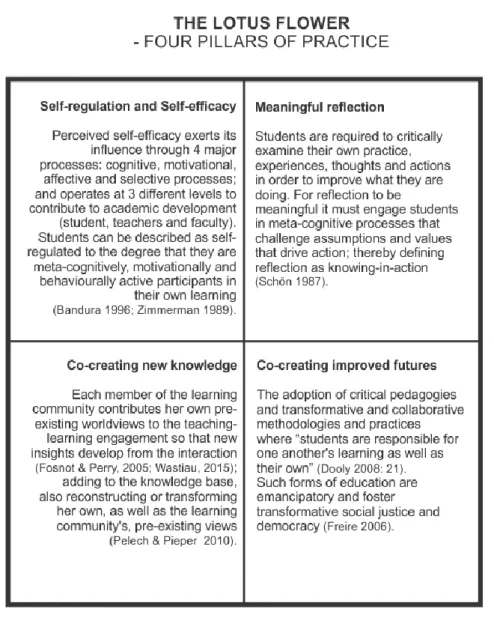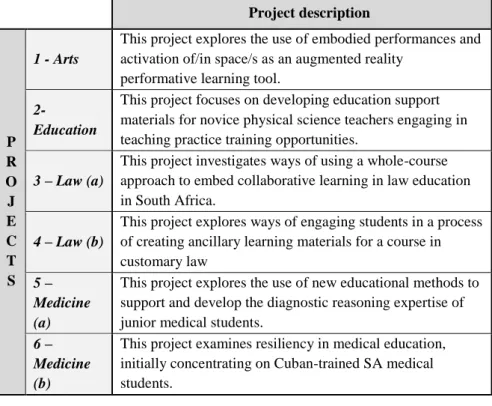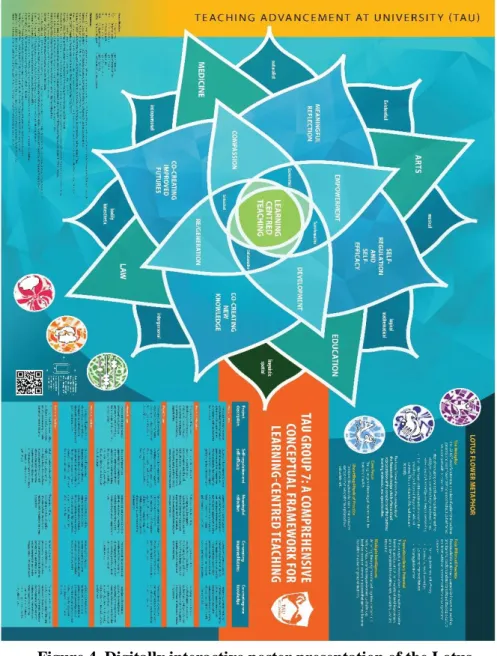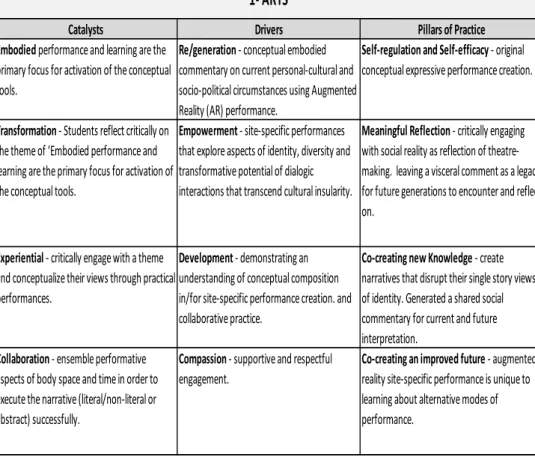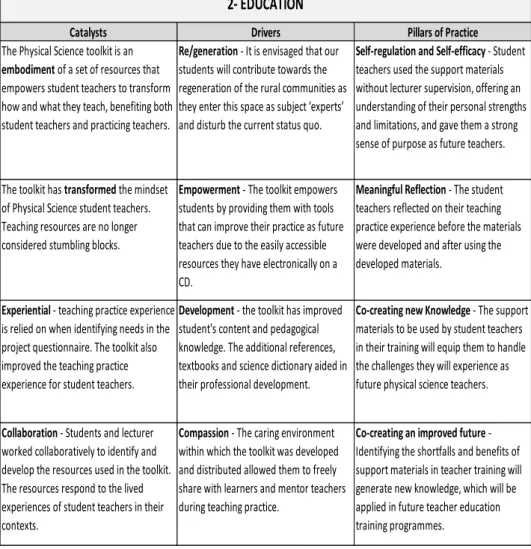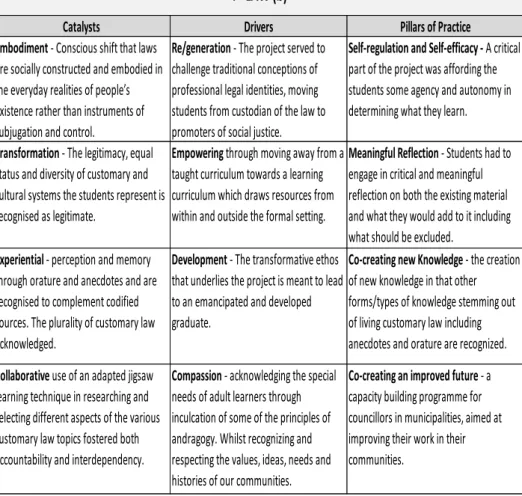These conversations, both face-to-face and online, were supplemented by extensive reading of the literature relevant to the concepts included in the framework. This paper reporting the development and validation of the framework was written at the end of the fellowship program. During early online conversations, the theory of multiple intelligences (Gardner 2006) was invoked as an essential component of the framework.
The name of the group subsequently changed to 'Group 7: Lotus', with each member identified as. Further features of the Lotus image emerged, including spiritual references to be associated with higher knowledge and lifelong learning.
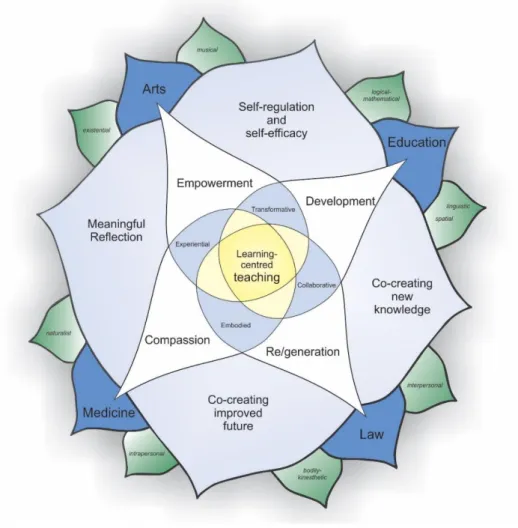
Phase Four
Finally, the common conceptual framework was subjected to peer criticism in the form of a poster presentation on the last day of the TAU fellowship program. The poster depicted the image of a lotus flower with an explanation of the layers (petals) of the flower. In addition, an augmented reality (Kipper & Rampolla 2013) digital application called Aurasma (2016) was used to embed short video presentations of the respective projects in the poster to show how each Fellow applied the framework to his/her individual project.
This project explores the use of embodied representations and the activation of space/spaces as augmented reality. This project focuses on the development of educational support materials for beginning physics teachers who engage in training opportunities for teaching practice. This project explores ways of using a whole course approach to incorporate collaborative learning into legal education in South Africa.
This project explores ways of involving students in a process of creating supplementary learning materials for a course in customary law. This project investigates the use of new educational methods to support and develop the diagnostic reasoning expertise of junior medical students.
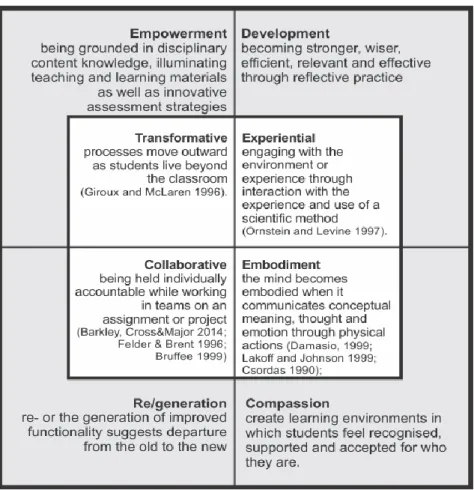
Results
ARTS
The Physical Science Toolkit is an embodiment of a set of resources that enable student teachers to transform how and what they teach for the benefit of student teachers and practicing teachers alike. Self-regulation and self-efficacy - Student teachers used the support materials without instructor supervision, which provided an understanding of their personal strengths and limitations and gave them a strong sense of purpose as future teachers. Empowerment - The toolkit empowers students by giving them tools to improve their practice as future teachers due to the easily accessible resources they have electronically on a CD.
Meaningful reflection - The student teachers reflected on their experience in teaching practice before developing the materials and after using the developed materials. Co-creating new knowledge - The support materials that will be used by student teachers during their education will equip them to meet the challenges they will face as future science teachers. Collaboration - Students and teachers worked together to identify and develop the resources used in the toolkit.
Compassion – The caring environment within which the toolkit was developed and distributed allowed them to freely share with learners and mentor teachers during teaching practice. Co-creating an improved future - Identifying the deficits and benefits of support materials in teacher training will generate new knowledge, which will be applied in future teacher training programs.
EDUCATION
Re/Generation - It is envisaged that our students will contribute to the regeneration of the rural communities as they enter this space as subject matter experts. Meaningful Reflection - The design of the collaborative learning module was based on the guided reflection of final year LLB students on their experiences of collaboration during training. Co-create new knowledge - The module forms a community of knowledge makers who co-create new knowledge and their own understanding of the field.
Compassion - The ability to interact with others, respecting and appreciating their differing views are core aspects of collaborative learning design. Creating a better future together - A key outcome of the module is to train law students to pursue justice for their future clients and social justice in general in a collaborative way. Re/Generation - The project served to challenge traditional notions of professional legal identities, transforming students from guardians of the law into promoters of social justice.
Self-Regulation and Self-Efficacy - A critical part of the project was to give the students some agency and autonomy to determine what they learn. Collaborative use of an adapted puzzle learning technique in the research and selection of different aspects of the different customary law topics promoted both accountability and interdependence. Compassion - recognition of the special needs of adult learners by inculcating some of the principles of andragogy.
Co-creating an improved future - a capacity building program for councilors in municipalities, aiming to improve their work in their communities.
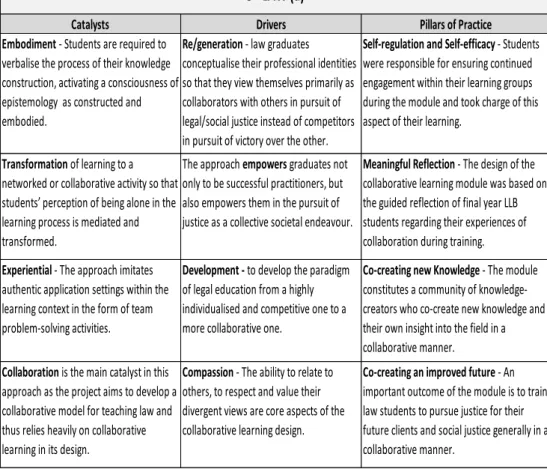
4 - LAW (b)
Development - The transformative ethos underlying the project should lead to an empowered and developed graduate. Creating new knowledge together - creating new knowledge by recognizing other forms/types of knowledge arising from living common law, including anecdotes and eloquence. Re/Generation - The mandate to train health professionals capable of addressing the complex and interdependent health care needs of the 21st century requires a pedagogy of regeneration that develops graduates into change agents.
Self-regulation and self-efficacy - The project examined the impact of new teaching methods on medical students' beliefs of self-efficacy with regard to their clinical reasoning abilities. Empowerment - Teaching/learning methods that positively impact beliefs about self-efficacy empower students to persevere in learning complex skills such as clinical reasoning. Meaningful Reflection - Use of structured reflection schemes, clinical reasoning ability, evaluated and deliberately used clinical information to substantiate a differential diagnosis made during real patient encounters (reflection-in-action).
Experiential - Students practiced their clinical reasoning skills in authentic patient encounters in an outpatient setting. Developing students' clinical reasoning skills encouraged the development of new teaching/learning approaches evaluated in this project. Co-creating new knowledge – this project advances our understanding of the effects of new methods on medical students' self-efficacy beliefs regarding their diagnostic reasoning ability.
Creating a better future together - Improving clinical reasoning is likely to have a positive impact on the process of learning these skills and ultimately improve diagnostic expertise, which should reduce diagnostic errors and improve patient care.
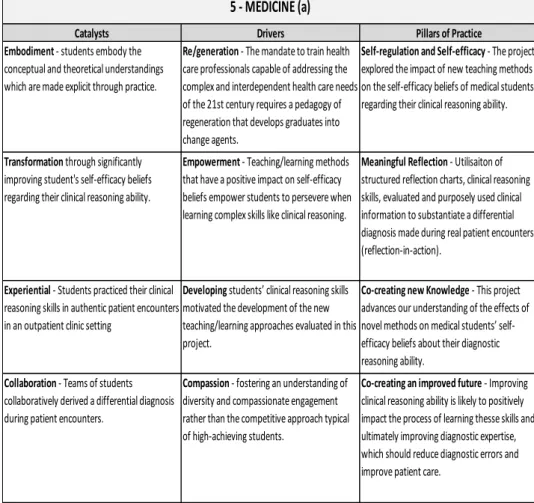
Discussion
This article does not provide a detailed description of the theoretical underpinnings of the concepts embedded in the framework. The process of identifying existing concepts that bridge domains led to the next level of the framework, the drivers of the teaching and learning enterprise, i.e. then the group engaged in a longer (six month) process of revising and revising the new framework using different disciplinary perspectives viz.
A critical part of developing the framework was bridging the statement-action gap. This happened during the transition from a text-based framework to a visual representation of the framework using the metaphor of a flower. The group believes this was the "tipping point" of the process and the step that reinforced the inter- and trans-disciplinarity of the framework.
The potential utility of the conceptual framework in the diverse landscape of higher education was explored through a process of peer review (a poster presentation during the TLU fellowship program) and preliminary validation (Jabareen 2009) using six authentic HE- teaching projects representing four diverse professions. This was done to obtain an overview of how the petals of the Lotus framework can be (re)positioned within discipline-specific contexts. This elegantly demonstrates the direct applicability of some of the simpler concepts contained in the framework without the need for more careful analysis to uncover convergence.
Further work using a large sample of teaching and learning projects to determine the wider utility of the Lotus conceptual framework in higher education is clearly needed.
Concluding Remarks
In addition, this approach also prevented the misunderstandings that arise “in interdisciplinary meeting places as a result of the inability, and perhaps the continued unwillingness to learn the language of the other” (Newman 2006: 75). The approach does suggest that the dialogical process was not interrupted by differing views during the process of constructing the Lotus framework. However, each of these conversations was tempered by the shared goal of finding a common platform for meaningful engagement and a conscious venture to "see your own thinking, suspend your epistemic beliefs, and engage in productive dialogue" (Vanasupa et al. 2012) to achieve this result.
Other strategies that facilitated difficult conversations were a shared recognition of the value and need for disciplinary pedagogy outside of clearly demarcated interdisciplinary spaces; and the reconceptualization of the framework as a Lotus image, which provided a broader understanding of the complexities of working in a discipline-based world and an unwavering commitment to the ethos of the TAU programme, i.e. a key success indicator of whether the TAU interdisciplinary community of practice will survive beyond the formal fellowship program is Fellows' ability to sustain collaboration within their institutional contexts and, more importantly, to expand networks beyond their institutional contexts. By the time this article was completed, members of the G7 had developed cooperative relationships in three of the provinces and created a cross-regional network of fellows in traditional universities and universities of technology.
This engagement with collaboration suggests that Lotus's conceptual framework may be sufficiently durable and flexible to facilitate interdisciplinary dialogues about teaching and learning in higher education. Further work is needed to interrogate this claim and provide further evidence to support the broader applicability of the framework.
Knowledge claims and codes of legitimation: Implications for recontextualizing curricula in South African higher education. Challenges in interdisciplinary, integrated projects: Reflections on the case of faculty members' lack of cooperation.
